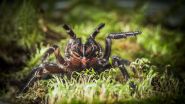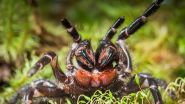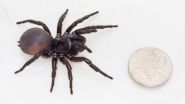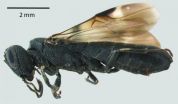Large funnel-web spider find surprises scientists
Scientists studying funnel-web spiders in Australia's south east have found a large example of an unexpected funnel-web species
2015-09-08
(Press-News.org) Scientists studying funnel-web spiders at Booderee National Park near Jervis Bay on the New South Wales south coast have found a large example of an unexpected funnel-web species.
The scientists believe the 50-millimetre spider is a species of the tree-dwelling genus Hadronyche, not the ground-dwelling genus Atrax, which includes the Sydney funnel-web, the only species reported in the Park's records.
"It's remarkable that we have found this other species in Booderee National Park," said Dr Thomas Wallenius, from The Australian National University (ANU).
"It shows we still have a lot to learn about what's out there in the bush.
"It may even turn out to be a new species of funnel-web," said Dr Wallenius, a biologist in ANU Research School of Biology.
There have been 13 recorded deaths from funnel-web bites, and none since an antivenom was developed in 1981. The development of an antivenom was prompted when scientist Struan Sutherland heard of the death of a seven-year-old girl who was bitten by a funnel-web near Jervis Bay.
The discovery of the spider is part of a larger biodiversity study of the area, Dr Wallenius said.
"The Jervis Bay region has a wide variety of both plant and animal species, as northerly and southerly ocean currents meet, which makes it a rich area to study," he said.
Dr Wallenius was searching for funnel-webs in Booderee National Park when he found the female funnel-web in her lair, burrowed into a rotting log.
"They build a silk-lined burrow inside the hollow log which can be up to two metres long. She had probably been living in there for 25 to 30 years," he said.
Dr Wallenius said other spiders are often mistaken for funnel-webs, so members of the public should not panic if they think they have found one.
"The males are more likely to be encountered in the summer months, and may be more aggressive, but contrary to common belief funnel-webs can't jump."
INFORMATION:
Images of the funnel-web spider are on the ANU website.
ELSE PRESS RELEASES FROM THIS DATE:
2015-09-08
Graphene, the ultra-thin, ultra-strong material made from a single layer of carbon atoms, just got a little more extreme. University of British Columbia (UBC) physicists have been able to create the first ever superconducting graphene sample by coating it with lithium atoms.
Although superconductivity has already been observed in intercalated bulk graphite--three-dimensional crystals layered with alkali metal atoms, based on the graphite used in pencils--inducing superconductivity in single-layer graphene has until now eluded scientists.
"This first experimental realization ...
2015-09-08
Social network Flickr and citizen science website BugGuide have helped scientists to expand the known range of a rarely collected parasitic woodwasp, native to the eastern United States. Partially thanks to the two online photograph platforms, now the species' distribution now stretches hundreds of miles west of previous records. Previously known from only 50 specimens mainly from the Northeast, now the species was discovered in the Ozark Mountains by researchers from the University of Arkansas. Their study is published it in the open access journal Biodiversity Data Journal.
Spurred ...
2015-09-08
[Basel, Switzerland - 8 September 2015] The Drugs for Neglected Diseases initiative (DNDi) has announced today at the 9th European Congress on Tropical Medicine and International Health (ECTMIH) in Basel, Switzerland, the successful completion of Phase I human clinical trials for SCYX-7158 (AN5568), the first oral drug candidate specifically developed from the earliest drug discovery stage to combat human African trypanosomiasis, or sleeping sickness, a deadly parasitic disease transmitted by the tsetse fly.
The Phase I study, conducted in France, assessed the safety, ...
2015-09-08
Edible dormice (Glis glis) spend about eight months on average in hibernation. Wildlife biologists from the Research Institute of Wildlife Ecology of the Vetmeduni Vienna have shown for the first time that these animals can hibernate for up to 11.4 months. "This may be a world record," says Claudia Bieber, co-author of the study. "Dormice in our climate zone don't just spend the winter months underground, they sometimes begin hibernating in summer."
The animals do not hibernate for so long every year, but only in years when beech trees produce few beechnuts. Successful ...
2015-09-08
In the new study 'Building trust: Heart rate synchrony and arousal during joint action increased by public goods game' (Journal of Physiology and Behavior) PhD and assistant professor Panagiotis Mitkidis and colleagues from the Interacting Minds Centre at Aarhus University studied the link between heart rate and trust. They had 37 pairs of participants do a cooperative task involving building LEGO cars. The control group only did the LEGO task, while a second group played an investment game in between the building sessions. The game, known as the 'Public Goods Game', had ...
2015-09-08
Select patients age 90 years and older with aortic stenosis (AS) can benefit from a relatively new, minimally invasive surgery for aortic valve replacement, according to an article in the September 2015 issue of the Annals of Thoracic Surgery.
Key points
Both transfemoral and transapical approaches to TAVR appear to be safe and effective for treatment of aortic stenosis in select patients age 90 years and older.
By 6 months post-surgery, most quality-of-life measures had stabilized at a level considerably better than baseline, meaning patients quality of life was ...
2015-09-08
Lueneburg. A recent study on the psychology of trademarks shows that they are perceived by the same psychological mechanisms as those, which enable the recognition of faces. The survey, whose result is particularly interesting for the advertising industry and brand management, originated at the Institute for Experimental Business Psychology at Leuphana University of Lueneburg.
For their investigation, Leuphana researchers Rainer Hoeger and Anne Lange compared the reactions of viewers to 16 well-known brands, such as Coca Cola, Rolex, Porsche or Apple and 18 computer-generated ...
2015-09-08
Trained volunteers are as good as professional astronomers at finding jets shooting from massive black holes and matching them to their host galaxies, research suggests.
Scientists working on citizen science project Radio Galaxy Zoo developed an online tutorial to teach volunteers how to spot black holes and other objects that emit large amounts of energy through radio waves.
Through the project, volunteers are given telescope images taken in both the radio and infrared part of the electromagnetic spectrum and asked to compare the pictures and match the "radio source" ...
2015-09-08
A rare, deadly form of skin cancer known as desmoplasmic melanoma (DM) may possess the highest burden of gene mutations of any cancer, suggesting that immunotherapy may be a promising approach for treatment, according to an international team led by UC San Francisco scientists. One of these mutations, never before observed in any cancer, may shield nascent DM tumors from destruction by the immune system and allow further mutations to develop.
"The focus of our lab has been to show that there's not just one 'melanoma' but many different types," said senior author Boris ...
2015-09-08
In the course of billions of years continents break up, drift apart, and are pushed back together again. The cores of continents are, however, geologically extremely stable and have survived up to 3.8 billions of years. These cores that are called cratons are the oldest known geological features of our planet. It was assumed that the cratons are stable because of their especially solid structure due to relatively low temperatures compared to the surrounding mantle. A team of German-American scientists now discovered that these cratons that were assumed to be "as solid as ...
LAST 30 PRESS RELEASES:
[Press-News.org] Large funnel-web spider find surprises scientists
Scientists studying funnel-web spiders in Australia's south east have found a large example of an unexpected funnel-web species





